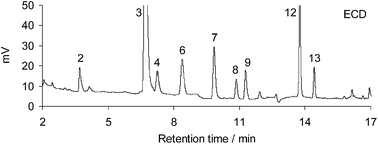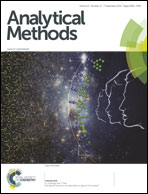Optimizations of large volume-direct aqueous injection-gas chromatography to monitor volatile organic compounds in surface water
Abstract
For the trace determination and automated continuous monitoring of volatile organic compounds (VOCs) in surface water, a large volume-direct aqueous injection-gas chromatography (LV-DAI-GC) method was optimized for the following parameters: packed sorbent, inlet temperature, injection volume, detector configurations and sample renewal. Using the packed sorbent lab-made with lithium chloride and diatomite 101 W, at an inlet temperature of 140 °C, 14 typical VOCs were separated from a 50 μL water matrix in 0.3 min. Coupled with a flame ionization detector (FID), an electron capture detector (ECD) and a flame photometric detector (FPD), the method quantification limits (MQLs) for the 14 typical VOCs were 0.008–7 μg L−1. For the samples from the simulated VOC pollution incidents, the relative standard deviations (RSDs) and relative errors (REs) were 5.9% and 9.5%, respectively. For real samples from a river polluted with VOCs, the quantitative results using LV-DAI-GC agreed well with those of purge-and-trap GC (PT-GC). The optimized reliable LV-DAI-GC could be applied to the automated continuous monitoring of VOCs in surface water and an early warning of VOC pollution incidents.


 Please wait while we load your content...
Please wait while we load your content...